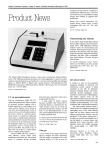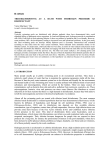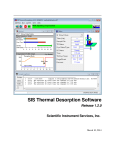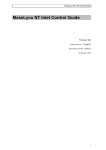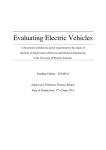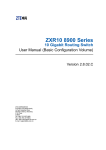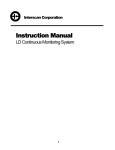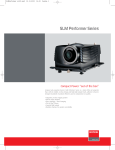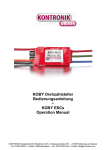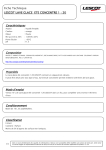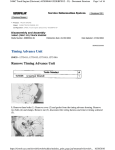Download June 2000 - Scientific Instrument Services, Inc.
Transcript
The Mass Spec Source ™ Vol. XXII, NO.1 Spring, 2000 For Mass Spectrometry and Chromatography Vacuum Pump Exhaust Filters . . . . . . . . . . . . . . . . . . . . . . . . .4 The first of three articles reporting on the effectiveness of filters designed for use on the exhaust of vacuum pumps. Replacing a DeTech Electron Multiplier in the Agilent 5973 MSD . . . . . . . . . . . . . . . . . . . . . . . .10 Replacing an electron multiplier can be successfully accomplished in just 15 minutes after the instrument is cooled down to the touch. All that is required are a pair of clean room gloves and the DeTech Model 2300 Electron Multiplier. NEW - SIS Monthly E-mail Newsletter! Beginning in July, SIS will be distributing a monthly e-mail newsletter on SIS products, services, promotions, news and other mass spectrometer related information. To receive this free newsletter fill in the attached form (pg.15) with your e-mail address and return it to SIS by mail or drop it off at the ASMS meeting. The Tradition Continues at ASMS O nce again SIS will be attending the annual ASMS meeting in Long Beach California on June 12 - 15. SIS will be providing our traditional ice cream treats in our ASMS suite. The SIS hospitality suite hours will be Monday through Wednesday from 7:30 - 10:30 pm. Stop by and receive our free 10-in one screwdriver after filling out the attached survey form (See page 15). We have invited three other companies to share our suite. These include DeTech, the fastest growing manufacturer of mass spectrometer detectors, Prolab Resources, a service company and manufacturer of replacement data systems, and Mass Sensors, a manufacturer of small mass spectrometers for process analytical and educational uses. In addition SIS will be sponsoring lunchtime presentations at our hospitality suite. (See next page.) SIS Posters at ASMS C O N T E N T S SIS Hospitality Suite . . . . . . . . . . . . . . .1 ASMS Seminar Abstracts . . . . . . . . . . . .2 Terms and Conditions . . . . . . . . . . . . . . .2 AutoDesorb/TD4 vs. Transfer Line . . . .3 Vacuum Pump Exhaust Filters . . . . . . . .4 DeTech Multipliers . . . . . . . . . . . . . . . .12 SGE MS-noVent . . . . . . . . . . . . . . . . . .13 10-in-1 Screwdriver . . . . . . . . . . . . . . .14 The Mass Spec Source Summer 2000 1. Controlling Laboratory Air Contamination from Rotary Vacuum Pumps by Using a Two-Stage Vacuum Pump Exhaust System. by John Manura - Poster # 1270 2. Analysis of Silicone Contaminants on Electronic Components by Thermal Desorption GC-MS. by Eric Butrym - Poster # 1425 SIS Topical Seminars at ASMS SIS is sponsoring three introductory seminars at this year's ASMS conference. Each presentation is designed as an introduction to the selected topic. These walk-in sessions will be held from 12:15 - 1:00 on each day in our hospitality suite, Hyatt Seaview C (first floor). Monday Lunch Applications of Thermal Desorption - Volatile and Semi-Volatile Analysis in Air by Stuart Batterman, University of Michigan Tuesday Lunch How AMDIS Could Have Saved My Sister's Marriage by O. David Sparkman AMDIS attempts to reconstruct original mass spectra for individual components in arbitrarily complex GC/MS and LC/MS reconstructed total ion current (RTIC) chromatograms and, if a target library is provided, AMDIS can directly identify target compounds. AMDIS is especially useful when an RTIC chromatographic peak represents multiple components. Regardless of each component’s concentration, pure mass spectra are deconvoluted for analysis. Air sampling using sorbents, thermal desorption, and gas chromatography is a versatile method for identifying and quantifying trace levels of volatile organic compounds (VOCs). Points to be discussed include the appropriate choices of sorbents and method parameters in order to accommodate a wide range of compounds and high humidity. The advantages of an automated short-path system for minimizing artifacts, losses, and carry-over effects are illustrated. As examples, results will be presented that demonstrate the performance of a thermal desorption method for 77 VOCs using laboratory and field tests and a dual sorbent system (Tenax GR, Carbosieve SIII). Laboratory tests showed that the method requirements for ambient air sampling were easily achieved for most compounds, e.g., using the average and standard deviation across target compounds, blank emissions were ≤0.3 ng/sorbent tube for all target compounds except benzene, toluene and phenol; the method detection limit was 0.05 ±0.08 ppb, reproducibility was 12 ±6%, linearity as the relative standard deviation of relative response factors was 16 ±9%, desorption efficiency was 99 ±28%, samples stored for 1 to 6 weeks had recoveries of 86 ±9%, and high humidity samples had recoveries of 102 ±11%. Due to sorbent, column and MSD characteristics, performance was somewhat poorer for phenol groups, ketones, and nitrogen containing compounds. The laboratory results were confirmed in an analysis of replicate samples collected in two field studies that sampled ambient air along roadways and indoor air in a large office building. Replicates collected under field conditions demonstrated good agreement except at very low concentrations or for large (> 4 l volume) samples of high humidity air. Overall, the method provides excellent performance and satisfactory throughput for many applications. AMDIS has been designed to reconstruct "pure component" spectra from complex RTIC chromatograms even when components are present at trace levels. For this purpose, observed chromatographic behavior is used along with a range of noise-reduction methods. AMDIS is distributed with specialized libraries (environmental, flavor and fragrance, and drugs and toxins), that were derived from the NIST98 Library. AMDIS has a range of other features, including the ability to search the entire NIST98 Library with any of the spectra extracted from the original data file. It can also employ retention index windows when identifying target compounds and can make use of internal and external standards maintained in separate libraries. A history list of selected performance standards is also maintained. Terms and Conditions Warranty Scientific Instrument Services (S.I.S.) continues to supply "The Mass Spec Source" newsletter as a service to our customers. Printed four times a year, it includes articles and notes on new products and procedures of interest to mass spec and GC users. Papers from all fields of scientific inquiry in which mass spectrometry and gas chromatography can play a role will be considered and subject to review. However, S.I.S. reserves the right to reject any article that is in direct competition with S.I.S. products. S.I.S. does not warranty that the items described herein are usable or fit for a particular purpose. Our company makes no representation as to condition or character of the merchandise. S.I.S. will not be responsible for consequential or special damages. Wednesday Lunch LC/MS Fundamentals and Applications by Mike Lee, Milestone Development Services Abstract: The combination of high-performance liquid chromatography and mass spectrometry (LC/MS) has had a significant impact on industrial applications over the past decade. Continual improvements in LC/MS interface technologies combined with powerful features for structure analysis, qualitative and quantitative, have resulted in a widened scope of application. An iterative cycle of "what is it?" and "how much is there?" continues to fuel the tremendous growth of LC/MS. This talk will review the fundamentals of LC/MS and provide perspective on strategies for method development. Current applications of LC/MS technologies and emerging industry trends will also be discussed. "The Mass Spec Source" Editorial Board & Newsletter Staff John J. Manura Christopher W. Baker Dr. Steve Colby Eric Butrym J. Philip Tielmann, Production Articles and Application Notes Editorials and reviews on new instrumentation and techniques for GC/MS will be considered for publication. These articles may be any length and our Graphics Department will aid you in any way you may need. Mass Spec Tips Any new ideas or tips that could benefit other mass spectroscopists can be submitted for inclusion in this section. TM For More Information Anyone interested in writing in any of the areas above should contact the editor of the Mass Spec Source, at (908) 788-5550. We are always trying to improve this newsletter, if you have any suggestions please give us a call. Thanks for your continued support. Scientific Instrument Services, Inc. 1027 Old York Road Ringoes, NJ 08551-1039 Phone: 908-788-5550 FAX: 908-806-6631 Web: http://www.sisweb.com, E-mail: http://www.sisweb.com/contact Copyright 1999 by Scientific Instrument Services, Ringoes, NJ 08551 2 The Mass Spec Source Summer 2000 Mass Spec Desk Reference by O. David Sparkman The Mass Spec Survival Guide You will be able to: •Communicate more effectively through written and oral presentations •Verify that you are utilizing the correct terminologies •Submit higher quality proposals •Understand and utilize the appropriate formats and conventions You will have at your fingertips: •A complete list of correct and incorrect terminology •Important formulas and equations •A thorough overview of modern instrumentation and techniques •A comprehensive bibliography of mass spectral publications •Where to find information on any topic in mass spectrometry nal Book Ti tl tio di es Ad Whether you are a newcomer, teacher, manager, or experienced practitioner engaged in mass spectrometry, you will find this handy desk reference and invaluable tool for improving your results. on th Description Mass Spec Desk Reference Price $29.95 eb Part No. 0-9660813-2-3 W eW orl d W i d e The Mass Spec Source Summer 2000 3 Vacuum Pump Exhaust Filters Part I – A Two Stage Vacuum Pump Exhaust Filter System By John J. Manura, Scientific Instrument Services, Inc., 1027 Old York Road, Ringoes, NJ 08551 INTRODUCTION The quality of indoor air is affected by many factors including construction materials, heating and ventilation systems and emissions of volatile organic compounds (VOC's) from building furnishings, equipment, and maintenance supplies. In the laboratory, chemicals and instrumentation are additional contributors to the contamination of the indoor air. Vacuum pumps are widely used for mass spectrometers, electron microscopes, lyophilizers, and other vacuum equipment. These pumps can be a major source of indoor air contamination. It is normally recommended that these vacuum pumps be vented outside the room or to a laboratory exhaust hood. However this is not always practical when the instrumentation is located within the interior of a building. Indoor air contamination by vacuum pumps originates from the lubricating oils used in the pumps, and also from chemicals that have contaminated the pump oil. When the vacuum pumps are first turned on, a large volume of air is pumped through the pump oil which causes a fine mist of oil fumes to be emitted from the pump exhaust and into the laboratory air. When the vacuum pumps are used in instruments such as mass spectrometers, all the residual organic chemicals analyzed by the mass spectrometer are trapped in the vacuum pump oil. Eventually these organics are purged out of the oil and into the laboratory air via the vacuum pump exhaust. Often the organic chemicals analyzed by these vacuum system instruments can be quite toxic or carcinogenic. This can present a serious environmental health problem in the laboratory. This is the first of three articles reporting on the effectiveness of filters designed for use on the exhaust ports of vacuum pumps (1, 2 & 3). This first article demonstrates the effectiveness of a two stage vacuum pump filtering system. The first stage filter consists of an oil mist eliminator to trap the heavy oils from the pump oil mist and return them to the vacuum pump. The second stage is a charcoal trap for the containment of volatile organics in the vacuum 4 The Mass Spec Source Summer 2000 pump exhaust. The second article in this series (2) describes the design of the oil mist eliminator and includes additional studies of the effectiveness of the oil mist eliminator. The third article in this series (3) describes the efficiency of the charcoal trap in greater detail. The combination of the two vacuum pump exhaust filters described in this article can provide for efficient and safe trapping of emissions from laboratory vacuum pumps and can improve the quality of air in the instrumentation laboratory. EXPERIMENTAL Stage 2 Filter Carbon Filter Trap Variable Gas Leak 0 to 1000 ml/min Vacuum Pump Intake Port Gas Ballast Clamp Stage 1 Filter Oil Mist Eliminator Clamp Vacuum Pump Exhaust Port Figure # 1 – Vacuum Pump Exhaust Filtering System Mounted on a Vacuum Pump. The two stage vacuum pump exhaust filtering system is shown above (Figure # 1). The two filters attach in series to the exhaust port of a vacuum pump. For these studies, an Alcatel oil mist eliminator was used (Scientific Instrument Services part # 66827) as the stage 1 filter. An NW25 vacuum pump exhaust fitting was first attached to the exhaust port of the vacuum pump, and the Oil Mist Eliminator was clamped to this fitting using a centering ring and clamp. The Stage 2 charcoal trap used for this study is the Koby charcoal exhaust filter (Scientific Instrument Services Part # KA-1), which is fitted with an adaptor to mate it to the NW fitting on top of the oil mist eliminator. The two filters are clamped together using a centering ring and clamp. All studies were performed on a BOC Edwards model E2M1.5 rotary vacuum pump, which is the standard model used on the Agilent mass spectrometers. The old oil in the pump was drained and the pump was charged with a volume of Inland 45 pump oil (Scientific Instrument Services). Inland 45 pump oil is the vacuum pump oil of choice because it is a highly refined oil comprised of aliphatic hydrocarbons with chain lengths of between 20 and 40 carbon units. The pump was run for two hours and the oil drained. The pump was again filled with a full charge of Inland 45 pump oil and run for 2 hours with the gas ballast valve open and then for an additional 2 hours with the gas ballast valve closed before any testing was done. This cleaning and flushing procedure assured that the pump was free of contaminants from the previous use of the vacuum pump. For this study a micro-needle valve was attached to the intake port of the vacuum pump to permit a calibrated flow of air into the vacuum pump. The flow through the needle valve was adjusted to 100 ml/min (or 300 ml/min for some studies) and calibrated with a Gilibrator Air Flow Calibration System (Scientific Instrument Services Part # 800844-2). Exhaust After Charcoal Trap Stage 2 AutoDesorb™ Tower SIS AutoDesorb™ System Automated Short Path Thermal Desorption 12 Tube Carousel PC Controls the AutoDesorb™ Hewlett-Packard 6890 GC GC Injection Port AutoDesorb™ Electronics Console GC/MS Interface CryoTrap MS Source HP 5973 MSD Capillary Column Figure # 3 – Schematic of the SIS AutoDesorb System on a GC/MS System Variable Gas Leak 0 to 1000 ml/min Exhaust After Oil Mist Eliminator Stage 1 Pump Exhaust No Filtering Stage A Figure # 2 – Analysis of Vacuum Pump Exhaust in the Two Stage Exhaust Filtering System For these studies, air samples were collected at three levels in the exhaust stream from the vacuum pump (Figure # 2). The first level (Stage A) is directly from the pump exhaust with no filtering. Another air sample was collected after the oil mist eliminator (Stage 1) and the final air samples were collected after the charcoal trap (Stage 2) and right before the exhaust air would enter the laboratory air. Thermal Desorption tubes were packed with 100 mg of Tenax TA and flow conditioned with pure nitrogen at 50 ml/min at 300°C for 3 hours. Air samples were collected from the three pump stages onto the Tenax adsorbent traps at a collection rate of 25 ml/min for 20 minutes (500 ml total) using a Gilian LFS-113 Air Sampling Pump (Scientific Instrument Services). The collected samples were analyzed using the SIS Automated Short Path Thermal Desorption System (AutoDesorb Model 2000, Scientific Instrument Services), which is described in previous articles (4) and shown below (Figure # 3). The desorption tubes were attached to the AutoDesorb system and first purged with 30 ml of helium. The desorption tubes were then desorbed from 100 to 250°C at a rate of 60° per minute and held at 250° for a total desorption time of 6 minutes. The desorbed analytes were trapped on a GC Cryo-Trap (Scientific Instrument Services), which was pre-cooled to -65°C using liquid CO2. The AutoDesorb system was attached to an Agilent Technologies 6890 GC for the separation of the analytes and the Agilent 5973 MSD to detect and identify the analytes. The GC column for these studies was an Agilent DB5-MS, 0.25 u film thickness, x 0.25 mm I.D. x 30 meters long. A 6" long DB-5, 1.5 u film thickness x 0.53 mm I.D. guard column was used at the front of the GC column and inside the Cryo-Trap. When the desorption was complete, the Cryo-Trap was rapidly heated to 250°C. The GC column was held at 40°C for 5 minutes and then temperature programmed to 280°C at 10° per minute. The total GC run time was 29 minutes. The Agilent MSD was operated in the EI mode and scanned from 35 to 450 daltons. For the studies of the ability of the filters to trap volatiles, 10 ul of gasoline was injected directly into the vacuum pump. Gasoline was selected because it contains a wide range of volatile and semi-volatile organics and would accurately simulate the wide range of chemicals that might be injected into a mass spectrometer. DISCUSSION Oil Mist Eliminator Oil mist eliminators are designed to trap the heavy oil vapors or mists which escape from the vacuum pump during initial pump down, during extended operation or when using the gas ballast valve to purge or outgas the vacuum pump oil. The oil mist eliminator contains a replaceable paper cartridge inside the filter housing. The paper wick exposes the oil mist to a large surface area to adsorb the oil vapor and return it to the vacuum pump. When a vacuum pump is first turned on, this oil mist is easily seen as a fine mist, which enters the laboratory environment. See the second article in this series for a more thorough description of the oil mist eliminator (2). The effectiveness of the oil mist eliminator is demonstrated in Figure # 4. For this study, the purge leak valve on the vacuum pump inlet was opened and the leak flow was adjusted to 300 ml/minute. At the vacuum pump exhaust port (stage A) of the pump, a high concentration of high molecular weight hydrocarbons is exhausted from the pump as shown in the top total ion The Mass Spec Source Summer 2000 5 chromatogram - Stage 1), exhibit high concentrations of the volatile aromatics and hydrocarbons from the gasoline. Additional studies described in the second article of this series (2), demonstrates that these volatiles are not purged out of the vacuum pump oil very quickly, but are in fact purged out over many hours or days of continuous pumping. Therefore venting the vacuum pumps for a short period of time when hazardous materials are analyzed will not be effective in preventing these materials from entering the laboratory environment. The vacuum pumps must be externally vented continuously or a better system such as the addition of a charcoal trap is needed to trap these more volatile organics. Charcoal Traps Figure #4 – Efficiency of the Oil Mist Eliminator at Removing Hydrocarbons chromatogram in Figure # 4. A large number of straight and branched hydrocarbons were detected with carbon chains over 20 carbons in length. The bottom total ion chromatogram in Figure # 4 shows the air sampled after the oil mist eliminator. When the oil mist eliminator is used these high molecular weight organics are trapped by the filter and returned to the pump. They do not exhaust out of the oil mist eliminator and are not present in the chromatogram. This study demonstrates that the oil mist eliminators are quite effective at performing the job for which they have been designed, that is trapping the high molecular weight vacuum pump oils and returning them to the vacuum pump. Charcoal traps are ideally suited for the trapping of volatile and semi-volatile organics in air. The Koby charcoal trap used for this study has been designed for the trapping of volatile and semivolatile organics from the vacuum pump exhausts. Each trap contains about 100 grams of carbon with a surface area of about 1500 sq. meters per gram. This high surface area provides for very efficient air purification. These charcoal filters have a high adsorption capacity and affinity for adsorbing organic contaminants. Further testing described in the third article of this series (3), demonstrated that each charcoal trap could be saturated with 70 ml of gasoline with no volatile emissions being eluted from the filter. In addition to trapping volatile and semi-volatile organics, these charcoal traps will adsorb water, oil mist dirt (to 0.5 microns) and bacteria (to 0.5 microns). The Koby charcoal traps produce minimal backpressure to the vacuum pump, and can therefore operate safely on the exhaust port of the vacuum pump. Figure #5 – Trapping Efficiency of Filter Stages (1.0µl of gasoline injected into pump) However, the oil mist eliminators with their paper filters are not effective at trapping the lighter hydrocarbons and organics in the vacuum pump exhaust as shown in the chromatograms of the second study (Figure # 5). In this study 1.0 ul of gasoline was injected directly into the vacuum pump and the exhaust air subsequently collected at the exhaust port of the vacuum pump and after the oil mist eliminator and analyzed as described above. The exhaust at the top of the vacuum pump (top chromatogram - Stage A), as well as the exhaust after the oil mist eliminator (second 6 The Mass Spec Source Summer 2000 Figure #6 – Trapping Efficiency of Two Filter Stages (1.0µl of gasoline injected into pump) In the next study, 10 ul of gasoline was injected directly into the vacuum pump and the exhaust air from all three locations or stages of the pump filters was collected and analyzed as described above (Figure # 6). At the exhaust directly from the vacuum pump (top chromatogram - stage A) as well as the exhaust after the oil mist eliminator (middle chromatogram - Stage 1), high concentrations of the aromatics and hydrocarbons from the gasoline were detected. However the charcoal trap was extremely efficient at removing all the volatile organics from the vacuum pump exhaust. The exhaust from the top of the charcoal trap (bottom chromatogram – Stage 2) contained no peaks of any volatile or semivolatile organics. As shown above none of the light hydrocarbons including hexane and pentane were evident in the charcoal trap exhaust, nor was acetone or any of the aromatics common in gasoline present in the charcoal trap exhaust. ASSEMBLY OF SYSTEM The combination of the two exhaust filters are joined together, and to the vacuum pump, using standard NW (or QF) vacuum type connectors. If the vacuum pump exhaust port is not equipped with an NW type fitting (either NW10, 16 or 25), then the appropriate adaptor for the pump must be first installed. The oil mist eliminator is then attached to this fitting using a centering ring and ‘O’ ring using a quick clamp. The Koby filter comes with _" NPT male fittings on both ends of the trap. Therefore a NW flange to _" female adaptor must be first attached to the Koby filter before it is attached to the top of the oil mist eliminator using another centering ring and quick clamp. The oil mist eliminators, Koby charcoal traps as well as all the fittings necessary for the assembly of the dual exhaust filter system are available from Scientific Instrument Services (5). In addition complete kits for the common pumps are also available (5). CONCLUSION This is Part I of a three part series of articles on the effectiveness of the vacuum pump exhaust traps. Part I describes the two stage vacuum pump exhaust filter system for the complete treatment of vacuum pump exhaust (1). Part II describes the operation and the effectiveness of the oil mist eliminator (2). Part III of this series describes the charcoal trap and its effectiveness at removing volatiles and semi-volatiles from vacuum pump exhaust (3) Figure #7 – Vacuum Pump Exhaust After the Koby Air Filter An additional study (Figure # 7) demonstrates that the air exhausted by the vacuum pump through the Koby charcoal traps was cleaner than the normal indoor air in our testing facilities. Note that the results shown in this graph are shown at 50X scale expansion from the data shown in Figure # 5 previously. The small peaks shown in the graph are not from the gasoline, but are siloxanes from the GC septum. The Two Stage Vacuum Pump Exhaust Filter System has been shown to be an effective system for removing volatile and semivolatile organics from the exhaust of vacuum pumps and can help maintain an environmentally safe atmosphere in the instrumentation laboratory. The oil mist eliminator (Stage 1) has been shown to effectively trap the high molecular weight hydrocarbons from the pump oil and return these oils back into the vacuum pump. The charcoal trap (Stage 2) adsorbs and traps the volatile and semivolatile organics from the pump exhaust and prevents these organics from entering the laboratory environment. It is recommended that both filters be used. The oil mist eliminator traps the large volume of heavy oils which would otherwise quickly saturate the charcoal trap during initial pump down or when using the gas ballast valve to purge the pump oil. When both filters are used in series on a vacuum pump exhaust port, the exhaust from the final stage of filtering has been shown to be cleaner than the normal laboratory air. References Carbon Filter Trap Variable Gas Leak 0 to 1000 ml/min Adaptor Clamp Centering Ring Oil Mist Eliminator Clamp Centering Ring Pump Adaptor (1) Vacuum Pump Exhaust Filters, Part I – Two Stage Vacuum Pump Exhaust Filter System, by John J. Manura, April 2000, SIS Application Note # 82 http://www.sisweb.com/referenc/applnote/app-82.htm (2) Vacuum Pump Exhaust Filters, Part II – Oil Mist Eliminators, by John J. Manura, April 2000, SIS Application Note # 83 http://www.sisweb.com/referenc/applnote/app-83.htm (3) Vacuum Pump Exhaust Filters, Part III – Charcoal Exhaust Traps, by John J. Manura, April 2000, SIS Application Note # 84 http://www.sisweb.com/referenc/applnote/app-84.htm (4) Design, Development and Testing of a Microprocessor Controlled Automated Short Path Thermal Desorption Apparatus, by John J. Manura, Vinod T. Das, Christopher Baker, Daniel Lieske, John C. Miller, John Manos, Roland Roadenbaugh, Thomas G. Hartman, SIS Application Note # 80 http://www.sisweb.com/referenc/applnote/app-80.htm (5) Two Stage Vacuum Pump Exhaust Filter Systems, Scientific Instrument Services, 1027 Old York Road, Ringoes, NJ 08551, Phone: (908) 788-5550 http://www.sisweb.com/ vacuum/sis/exfilter.htm Figure #8 – Assembly of the Two Stage Vacuum Pump Exhaust Filtering System The Mass Spec Source Summer 2000 7 COMPLETE TWO-STAGE VACUUM PUMP EXHAUST FILTER KITS Features Two Stage Vacuum Pump Exhaust System • Purifies Vacuum Pump Exhaust Gases • Provides for a Safe Laboratory Environment Stage 1 - Oil Mist Eliminator • Eliminates Pump Oil Fumes • Returns Used Oil to Vacuum Pump Charcoal Trap Stage 2 - Charcoal Filter The charcoal trap (Stage 2) adsorbs and traps the volatile and semi-volatile organics from the pump exhaust and prevents these organics from entering the laboratory environment. Each trap contains about 50 grams of carbon with a surface area of about 1500 sq. meters per gram and has a high adsorption capacity for adsorbing organic contaminants. The charcoal traps also adsorb water, oil mist dirt and bacteria (to 0.5 microns). During initial pump down or when using the gas ballast valve, oil vapors exhaust from the vacuum pump. The oil mist eliminator (Stage 1) traps the hydrocarbons in this exhaust. The paper wick inside the oil mist eliminator exposes the oil mist to a large surface area to adsorb the oil vapor and return it to the vacuum pump. • Traps Organic Chemicals • Traps Particles & Bacteria to 0.5 microns Oil Mist Eliminator Pump Exhaust after Charcoal Trap Pump Exhaust after Oil Mist Eliminator Pump Exhaust with No Filtering 8 The Mass Spec Source Summer 2000 COMPLETE TWO-STAGE VACUUM PUMP EXHAUST FILTER KITS Alcatel Pump Filter Kit Kit Part # FK101 For all Models of Alcatel Vacuum Pumps with NW25 flange. Alcatel Vacuum Pump Kit (Kit FK101) contains the Alcatel Oil Mist Eliminator, Koby Filter and the fittings shown below. This kit is all you need to install the complete two stage exhaust filter to your Alcatel vacuum pump. It can also be used with any other manufacturers pumps that have an NW25 flange type fitting on the exhaust port. Part No. FK101 Description Alcatel Pump Filter Kit Price $223.20 Edwards Large Filter Kit Kit Part # FK201 For Edwards Models E1M5/8, E2M3/5/8 and RV3/5/8 pumps The Pump Filter Kit for the Edwards Pump includes the Edwards EMF10 Oil Mist Eliminator, Koby Charcoal Trap and all fittings needed to attach this two filter system on the larger Edwards vacuum pumps. This kit is to be used with Edwards models E1M5/8, E2M2/3/5/8 and the RV3/5/8 vacuum pumps. It can also be used with any other manufacturers pumps that have an NW25 flange type fitting on the exhaust port. Part No. FK201 Description Edwards Large Filter Kit Price $234.70 Edwards Small Filter Kit Kit Part # FK251 For Edwards Models E2M0.7, E2M1 and E2M1.5 pumps The Pump Filter Kit for the Edwards Pump includes the Oil Mist Eliminator, Koby Charcoal Trap and all the fittings needed to attach this two filter system on the Edwards series of vacuum pumps. This kit is to be used with Edwards models E2M0.7, E2M1 and E2M1.5 vacuum pumps. It can also be used with any other manufacturers pumps that have an NW10 flange type fitting on the exhaust port. Part No. FK251 Description Edwards Small Filter Kit Price $205.70 The Mass Spec Source Summer 2000 9 TECHNICAL APPLICATION NOTES Replacing an Electron Multiplier in the Agilent (HP) 5973 MSD Jay S. Ray - Detector Technology, Inc. Replacing an electron multiplier can be successfully accomplished in just 15 minutes after the instrument is cooled down to the touch. All that is required are a pair of clean room gloves and the DeTech Model 2300 Electron Multiplier. DeTech Model 2300 Step 1 Remove the top cover of the Mass Spectrometer. Step 2 Vent the instrument. Make sure that all voltages applied to the multiplier and the conversion dynode are turned off prior to venting the system. Step 3 Remove power and computer cables from the Mass Spectrometer. 10 The Mass Spec Source Summer 2000 TECHNICAL APPLICATION NOTES Step 4 Swing the Mass Spectrometer door open and locate the electron multiplier region. Step 5 Put on a pair of clean room gloves. To remove the old multiplier, simply push together the mounting clips and allow them to open so you can gain access to the multiplier. Then reach in and remove the existing multiplier from the manufacturer’s mount. Step 6 Take the DeTech Model 2300 and install it into the existing manufacturer’s mount. Close the clips. Typical Autotune for DeTech Model 2300 Samples: 8 Thresh: 100 Scan: 10.00 - 700.00 Abundance: 492672 Base: 69.00 176 Peaks 100 Ion Pol POS Emission EleEnergy Filament 75.4 69.9 2 25.26 90.2 28.0 18.07 HED EMVolts ON 1141 50 Repeller IonFocus EntLens EntOffs 40 PFTBA Samples OPEN Averages StepSize 8 3 0.10 30 Zones: MS Source MS Quad 250 150 100 90 80 70 60 When installing the new DeTech Model 2300 make sure of the following: 20 MassGain MassOffs AmuGain AmuOffs Wid219 DC Pol -305 -12 1735 129 -0.034 POS TurboSpd 10 1) The Anode Pin (output) is making good contact with the output plate on the mounting frame. 2) The back arm of the spring clip is making contact with the electron multiplier’s steel frame. Close the Mass Spectrometer’s door. Reconnect both the power and computer cables. Close the vent valve and replace the top cover. Your installation is now complete. Turn on the vacuum pumps. Refer to your user’s manual for pump time information. 0 100 Mass 69.00 219.00 502.00 200 Abund 492672 459392 47504 300 400 Rel Abund 100.00 93.24 9.64 IsoMass 70.00 220.00 503.00 500 Iso Abund 5556 20312 4905 600 Iso Ratio 1.13 4.42 10.33 Palmer Industrial Park • 9 Third Street • Palmer, MA 01069 Tel: (413) 284-9975 • Fax: (413) 284-9979 E-Mail: [email protected] • www.detechinc.com De Tech Detector Technology, Inc. The Mass Spec Source Summer 2000 11 “Committed to Excellence” Detech Manufactures a Complete Line of Quality and Affordable Electron Multipliers! T he DeTech family of multipliers is engineered for high performance and maximum reliability in applications ranging from low gain analog amplification to high gain pulse counting requirements. DeTech’s “Committed to Excellence” philosophy is not just a fancy slogan, it’s the way they do business. DeTech is committed to the manufacturing of a quality product as well as providing total customer support. All DeTech multipliers are comprehensively 100% tested before being shipped. 10% DISCOUNT on all DeTech Mass Spec Detectors (Limit of 5) Offer Good Through July 2000 (Photocopy this coupon and mail it in with your next order) 12 The Mass Spec Source Summer 2000 For Agilent Technologies (HP), Shimadzu, Finnigan & Varian GC/MS systems SAVE 6-12 HOURS 5 minute GC/MS Column Changeover Peak 3 - 4-chlorophenol Peak 4 - Decylamine Peak 5 - Undecanol 1 6 L ICA T N IDE PHY A R OG 5T A M O 7 CHR 2 3 4 ELIMINATES MS VENTING 1 2 3 4 5 6 7 8 9 min 9 min WITH ms-NoVent™ 1 CONNECTS SIMPLY TO MS INLET AND GAS LINES 6 2 3 PREVENTS MS AIR CONTAMINATION 5 7 IMMEDIATE AIR/WATER CONFORMANCE 4 1 2 3 4 5 6 7 8 WITHOUT ms-NoVent™ ial c e Sp S IS M AS rom S f 0% e v a S 1 Part No. Description 113400 Ms-NoVent Interface MS Specific Restrictors and Adapters 113405 HP5970 2 x Restrictor 113407 HP5971/5972 2 x Restrictor 113409 HP5973 2 x Restrictor 113424 HP5988A 2 x Restrictor 113422 HP5989 Engine 2 x Restrictor 113419 GCQ 2 x Restrictor,1 x Adapter 113426 SSQ7000 2 x Restrictor,1 x Adapter 113410 MS 5000/5050 2 x Restrictor,1 x Adapter 113412 Saturn 2000 2 x Restrictor,1 x Adapter 113414 Saturn 1,2 &3 2 x Restrictor,1 x Adapter List Price $ 650.00 $50.00 $50.00 $50.00 $50.00 $56.00 $82.00 $80.00 $82.00 $82.00 $82.00 ASMS Special Price $585.00 $45.00 $45.00 $45.00 $45.00 $50.40 $73.80 $72.00 $73.80 $73.80 $73.80 The Mass Spec Source Summer 2000 13 The SIS Tradition Continues at ASMS!! Get Your FREE 10-in-1 Screwdriver At Our Annual Ice Cream Hospitality Suite Date: Monday - June 12 Tuesday - June 13 Wednesday - June 14 Time: 7:30 - 10:30pm Hospitality Suite 12:00 - 1:00pm Lunchtime Lectures Place: Hyatt Hotel Hyatt Seaview C ( First Floor) Lunchtime Lecture Presentations at the SIS Hospitality Suite Monday: Applications of the AutoDesorb System Stuart Batterman - University of Michigan Tuesday: “How AMDIS Could Have Saved my Sister’s Marriage” - Dave Sparkman - NIST Wednesday: “LC/MS Fundamentals and Applications” Mike S. Lee - Milestone Development Services Scientific Instrument Services, Inc. Phone: (908) 788-5550 14 The Mass Spec Source Summer 2000 Web Site: http://www.sisweb.com To Receive Your FREE 10 in 1 Screwdriver Just Fill in this survey and bring it to our booth at ASMS Mass Spec User Survey 3. What Mass Spectrometer(s) do you have in your lab? Name Finnigan MAT ❐ 4500/4600 ❐ MAT90 ❐ Incos 50/500XL ❐ Trace/AQA ❐ TSQ 70/700/7000 Company Address Phone: ❐ ❐ ❐ ❐ ❐ GCQ LCQ Ion Trap ICP MS Other ❐ ❐ ❐ ❐ ❐ 5985/5988 5989 5990 GCD 1100LC/MSD VG/Fisons/MicroMass ❐ 70/70, ZAB ❐ Platform ❐ LC/MS ❐ MD800 ❐ ❐ ❐ ❐ Autospec TRIO 1000/2000 Quattro Other Varian ❐ Saturn I, II, III ❐ Saturn 2000 Other Manufacturers ❐ JEOL ❐ Sciex ❐ Hitachi ❐ Nermag ❐ Perkin-Elmer QMass ❐ Waters Integrity ❐ PE Bio Mariner ❐ LECO ❐ ❐ ❐ ❐ ❐ ❐ ❐ ❐ Agilent Technologies ❐ 5970 ❐ 5971 ❐ 5972 ❐ 5973 FAX: e-mail: 1. Would you like: ❐ S.I.S. GC/MS Supplies Catalog ❐ Printed ❐ CD ❐ Mass Spec Source Newsletter ❐ S.I.S. monthly e-mail newsletter ❐ A Software DEMO CD for NIST’98, SIMION 3D, and ProLab 2. Please check technique(s) you use: ❐ EI/CI ❐ CF/FAB ❐ LC/MS ❐ TOF ❐ Electrospray ❐ Thermospray ❐ Direct Probe ❐ ICP/MS ❐ APCI ❐ CE/MS ❐ FAB Extrel Shimadzu Vestec Balzers Nicolet Bruker Leybold Inficon Other New! - SIS Monthly E-mail Newsletter • Monthly Specials • News from SIS • New Products • New Services • Links to MS Resources To Get on This New E-mail List Fill in Your E-mail Address Above and Check the Appropriate Box in Section 1 The Mass Spec Source Summer 2000 15 Explore The World of Mass Spec S.I.S. Invites you to explore our web site. http://www.sisweb.com The S.I.S. Web Site is continually expanding. • MSLinks - expanded listings and reference materials • Books - expanded listings of scientific related books • Application Notes - on thermal desorption GC and GC/MS Scientific Instrument Services 1027 Old York Rd. Ringoes,NJ 08551 Bulk Rate US Postage PAID Permit No.388 Somerville, NJ
















